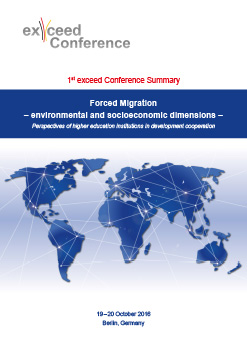Forced migration - environmental and socioeconomic dimensions
Perspectives of higher education institutions in development cooperation. 19 - 20 Oktober 2016, Berlin, Germany. 1st Exceed Conference Summary
02.05.2017
ISBN 978-3-95925-042-9
Printed version: 18,80 EUR
Online: http://nbn-resolving.de/urn:nbn:de:bvb:19-epub-30544-5
Buy: readbox unipress Bookstore
Recommended citation:
Radon, Katja; Haarstrick, Andreas; Ribbe, Lars; Doluschitz, Reiner; Scherrer, Christoph (Hrsg.) (2016): Forced Migration - environmental and socioeconomic dimensions. Perspectives of higher education institutions in development cooperation : 19 - 20 Oktober 2016, Berlin, Germany : 1st Exceed Conference Summary. München: Exceed Conference.
Inhalt
In 2009, five German higher education institutions – Technical University Braunschweig, University of Hohenheim, University of Kassel, Cologne University of Applied Sciences and Ludwig-Maximilians-University München – were selected to be part of the Excellence for Development Cooperation (Exceed) Program by the German Academic Exchange Service (DAAD) and the German Federal Ministry for Economic Cooperation and Development (BMZ). Since then, these centers together with their 37 partners in developing countries, have been establishing think tanks to contribute to the post-2015 development agenda. These five Exceed Centers combined forces to take a closer look at the environmental and socioeconomic dimensions of forced migration together with scientists, politicians and the public from around the world by participating in the first Exceed Conference in Berlin. This up-to-date topic was chosen to strengthen the connection between local research on conflicts and their consequences in today's world and global action towards the mitigation of these consequences. During the course of the conference, current research results were presented, challenges were discussed and new strategies to prevent forced migration were identified by using an interactive conference set-up.










